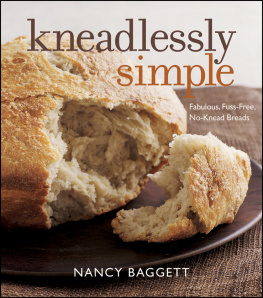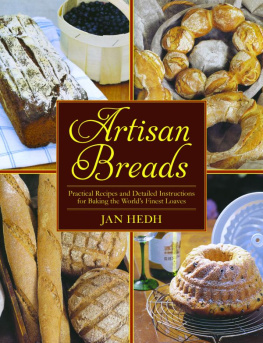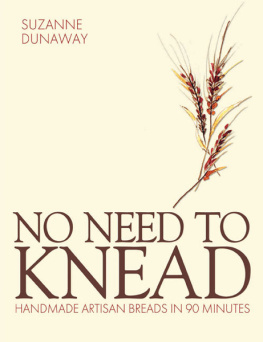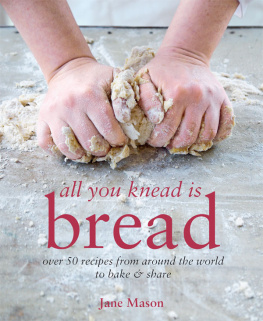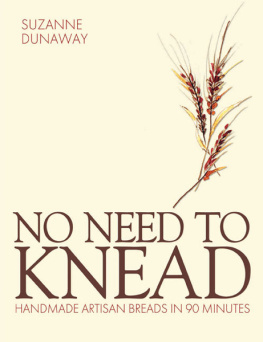No-Knead Brioche
From the kitchen of
Artisan Bread with Steve
Updated 5.10.2019
By
Steve Gamelin
Copyright 2014 by Steve Gamelin
All rights reserved. No part of this book may be used or reproduced, stored in a retrieval system, or transmitted in an form or by an meanselectronics, mechanical, or any otherexcept for brief quotations in print reviews without prior permission of the author.
Now that I have met the standard legal requirements I would like to give my personal exceptions. I understand this is a cookbook and anyone who purchases this book can, (a) print and share the recipes with their friends, as you do with your other cookbooks (of course, it is my hope they too will start to make no-knead bread and buy my cookbooks) and (b) you may share a recipe or two on your website, etc. as long as you note the source and provide instructions on how your audience can acquire this book.
Thanks Steve
Table of Contents

Note from Steve
The no-knead bread method has revolutionized bread baking. The average family can now have fresh from the oven bakery quality artisan bread in the convenience of their own home with little or no-kneading... Mother Nature does the kneading for you. No-yeast proofing... instant yeast does not need to be proofed in warm water prior to using. No mixer... ingredients can be combined with a spoon. It's almost as easy as making a bowl of Campbell's soup.
This is New Age Bread Baking. I understand what Italian bread, French bread, and baguettes are, and I understand the proper techniques for making those breads, but we live in a new age and we should embrace new ideas. Instead of trying to emulate bread methods of the past we should focus on our goal... to make great tasting, bakery quality, artisan bread with the methods and techniques that fit our busy schedules.
I believe in Smart & Easy. Note, I didnt say fast and cheap. I make no-knead bread because its the smartest, easiest, way to make bakery quality artisan bread and I believe my readers and subscribers are attracted to the no-knead method for the same reasons. In response to my readers and subscribers, I strive for convenience and address each recipe from a very practical standpoint... as, I believe, they would want me to develop my recipes.
I think youll enjoy this cookbook.
Steve
Ingredients
It only takes four ingredients to make bread... flour, salt, yeast and water.
Flour
Flour is the base ingredient of bread and there are four basic types of flour...
(1) Bread flour is designed for yeast bread. It has a higher percentage of gluten which gives artisan bread its airy crumb.
(2) All-purpose flour has less gluten than bread flour. I use all-purpose flour for biscuits, flatbreads, etc. In other words... I use it when I dont want an airy crumb.
(3) Self-rising flour is all-purpose flour with baking soda and baking powder added as leavening agents. Its intended for quick breads... premixed and ready to go. Do not use self-rising flour to make yeast bread. To see the difference between yeast and quick breads you may want to watch Introduction to No-Knead Beer Bread (a.k.a. Artisan Yeast Beer Bread) and Introduction to Quick Beer Bread (a.k.a. Beer Bread Dinner Rolls) .
(4) And there are a variety of specialty flours ... whole wheat, rye, and a host of others. Each has its unique flavor and characteristics. In some cases, you can substitute specialty flour for bread flour, but you may need to tweak the recipe because most specialty flours have less gluten. I frequently blend specialty flour with bread flour.
Flour is the primary ingredient... if you dont use the correct flour you wont get the desired results.
Note: To know how many cups of flour there are in a specific bag its typically on the side in Nutritional Facts. For example, this bag reads, Serving Size 1/4 cup Serving Per Container about 75. In other words 18.75 (75 times 1/4). Thats the technical answer, but in the real world (measuring cup versus weight) a bag of flour will measure differently based on density (sifted versus unsifted), type of flour (wheat is more dense than bread flour), humidity (flour weighs more on humid days), and all the other variables life and nature have to offer. Thus, there is no single correct answer, but for practical purposes figure a 5 lb bag of bread flour is 17 to 18 cups.
Salt
While it is possible to make bread without salt... you would be disappointed. There are three basics types of salt...
(1) Most baking recipes are designed to use everyday table salt unless specified otherwise. Unless youre experienced, it is probably smartest to use table salt for your baking needs.
(2) Kosher salt is excellent. I use it when I cook, but a tablespoon of kosher salt does not equal a tablespoon of table salt because kosher salt crystals are larger.
(3) And, I use specialty salt as a garnish... for appearance and taste. For example, I use sea salt to garnish pretzels.
Generally speaking, when salt is added as an ingredient and baked it is difficult to taste the difference between table, kosher and sea salt. When salt is added as a garnish and comes in contact with the taste buds... kosher or specialty salt is an excellent choice.
Yeast
Yeast is the magic ingredient which transforms flour and water into dough. Traditional no-knead recipes use 1/4 tsp yeast (we want the dough to rise slowly which allows the dough to develop flavor). Turbo recipes use 1-1/4 tsp yeast (ready to bake in 2-1/2 hours). There are three basic types of yeast...
(1) The most common is active dry yeast which is traditionally proofed in warm water prior to being added to flour.
(2) Instant dry yeast (a.k.a. instant yeast, bread machine yeast, quick rise, rapid rise, fast rising, etc.) which was designed for bread machines and does not need to be proofed in warm water why worry about proofing yeast if you dont have too.
(3) Some older recipes call for cake yeast (a.k.a. compressed yeast or fresh yeast), but its perishable. You can substitute active and instant dry yeast for cake yeast when using older recipes.
Update: While I respect the history of bread making and opinions of others, I do all my own testing. And, when I designed Turbo bread I found proofing technique was more important than the amount of yeast. In other words when I proofed at 78 to 85 degrees F. it didnt make any difference if I use 1-1/4 or 2-1/4 ounces yeast I got the same results. The reason is the manufacturing of yeast has significantly improved yeast (more live yeast and better strains) since the 1940s when recipes called for a 2-1/4 ounce packet of yeast. When you bake a lot, you can save a lot by reducing the amount is yeast.
Furthermore, because the quality of dry yeast has improved I now believe active dry yeast and instant yeast are interchangeable. Active dry yeast is a different stain of yeast (designed to act faster), but for all practical purposes the results is very similar.
Sugar
Sugar sweetens the loaf and provides nutriment for the yeast. Brioche dough uses refined sugar (everyday table sugar). It adds sweetness without the complexity of a new flavor.
Eggs & Butter
Egg yolks add fat and protein which gives brioche its yellow color and rich flavor. Butter adds fats and oils giving brioche its rich and tender crumb. The problem is fats, proteins and oils bind to glutens and inhibit development, which is why it is very important to provide yeast with a warm draft-free environment for proofing when using eggs and butter.


